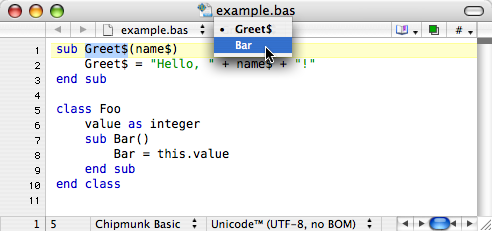

- CHIPMUNK BASIC IF COMMANDS UPDATE
- CHIPMUNK BASIC IF COMMANDS CODE
- CHIPMUNK BASIC IF COMMANDS FREE
- CHIPMUNK BASIC IF COMMANDS WINDOWS
If statements (and, closely related, case statements) allow us to make decisions in our Bash scripts.
CHIPMUNK BASIC IF COMMANDS CODE
They allow us to decide whether or not to run a piece of code based upon conditions that we may set.

If statements, combined with loops (which we'll look at in the next section) allow us to make much more complex scripts which may solve larger tasks. Like what we have looked at in previous sections, their syntax is very specific so stay on top of all the little details. character for character the same) whereas -eq does a numerical comparison meaning will return true. Basic If StatementsĪ basic if statement effectively says, if a particular test is true, then perform a given set of actions. If it is not true then don't perform those actions.

If follows the format below:Īnything between then and fi (if backwards) will be executed only if the test (between the square brackets) is true. It is always good practice to test your scripts with input that covers the different scenarios that are possible. The square brackets ( ) in the if statement above are actually a reference to the command test. This means that all of the operators that test allows may be used here as well. Look up the man page for test to see all of the possible operators (there are quite a few) but some of the more common ones are listed below. The length of STRING is greater than zero. INTEGER1 is numerically greater than INTEGER2 INTEGER1 is numerically equal to INTEGER2 The lengh of STRING is zero (ie it is empty). INTEGER1 is numerically less than INTEGER2įILE exists and the read permission is granted.įILE exists and it's size is greater than zero (ie.

it is not empty).įILE exists and the write permission is granted.įILE exists and the execute permission is granted. will return false as = does a string comparison (ie.
CHIPMUNK BASIC IF COMMANDS WINDOWS
Specifies that Windows should carry out the command only if the condition is false. As these BASICS were not free, a program written in one of these BASICs could only be listed and run if the user had that BASIC. IF NOT ERRORLEVEL number command IF NOT string1string2 command IF NOT EXIST filename command. FaST BASIC and GFA BASIC were two of the first of these third-party BASICs to be released. The relatively low quality of ST BASIC quickly opened up a market for third-party BASICs on the ST.
CHIPMUNK BASIC IF COMMANDS UPDATE
Regarding reports that MetaComCo was "one bug away" from releasing a long-delayed update to the language, it jokingly wondered "whether Atari has only one more bug to eliminate from ST BASIC or one more to add". After citing other flaws (such as ? 257 * 257 and ? 257 ^ 2 not being equivalent) the magazine recommended "avoid ST BASIC for serious programming".
CHIPMUNK BASIC IF COMMANDS FREE
Similar commands, such as x = 39.8 or x = 4.725, crash the computer the magazine described the results of the last command as "as bad a crash as you can get on the ST without seeing the machine rip free from its cables, drag itself to the edge of the desk, and leap into the trash bin". Compute! in September 1987 reported on one flaw that it described as "among the worst BASIC bugs of all time". The windows can only be selected with the mouse.


 0 kommentar(er)
0 kommentar(er)
